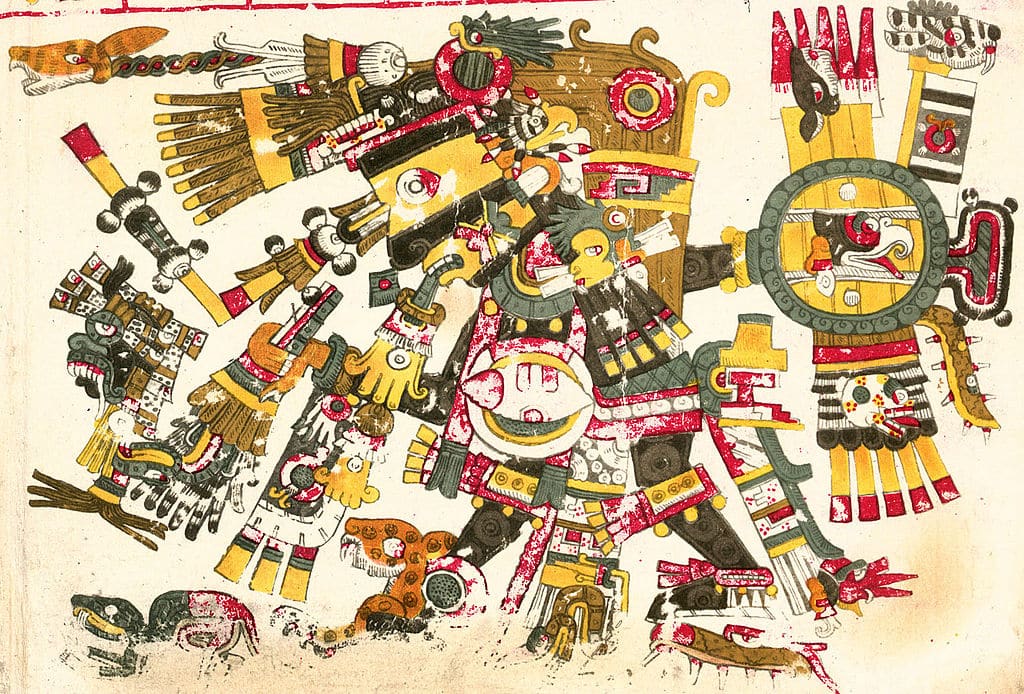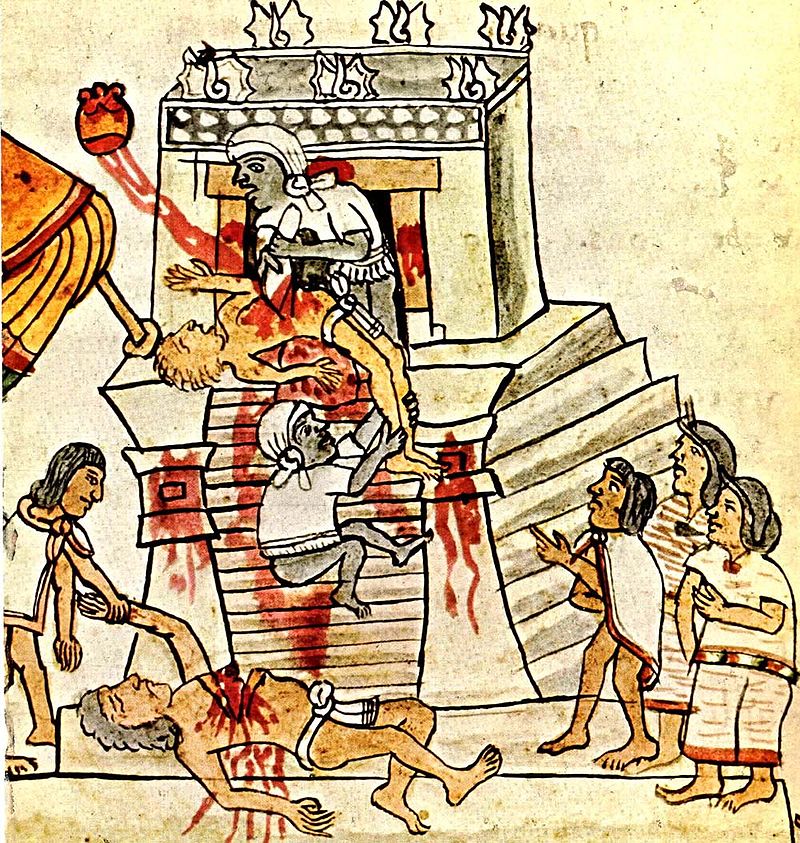Ancient Aztec Religion was similar to many ancient religions. There seemed to be a preoccupation with a fear of nature and a fear of the end of the world.
When Hernan Cortes came to the New World, the Aztecs did not have much separation between their religion and government. Their religion dictated how they ran their government, warfare, and much of their economy.
Jump to:
Aztec Religion: Pantheon
The Aztecs were pantheistic, meaning that they had many gods,
The Aztecs were a blended people group, and over time, many different gods that originated from different cultures found their way into the Aztec Pantheon. Many gods had multiple aspects with different names, where each name highlighted a specific function of a trait of the god. Occasionally, two distinct gods were conflated into one, and quite often, deities transformed into one another within a single story. Aztec images sometimes combined attributes of several divinities.

The Aztec Pantheon of gods can be classified into different groups:
Cultural Gods
- Tezcatlipoca
- Quetzalcoatl
- Tlaloc
- Mixcoatl
- Huitzilopochtli
Nature gods
- Metztli
- Tlaltecuhtli
- Chalchiuhtlicue
- Centzon Huitznahua
- Ehecatl
Gods of creation
- Ometeotl
- Huehueteotl/Xiuhtecutli
- Coatlicue/Toci/Teteo Innan/Tonantzin
Gods of pulque and excess
- Tlazolteotl
- Tepoztecatl
- Xochiquetzal
- Mayahuel
- The Auiateteo:
- Macuiltochtli
- Macuilxochitl
- Macuilcuetzpalin
- Macuilcozcacuauhtli
- Macuilmalinalli
- Centzon Totochtin
- Ometochtli
Gods of maize and fertility
- Xipe Totec
- Cinteotl
- Xilonen/Chicomecoatl
- Xochipilli
Gods of death and the underworld
- Mictlantecutli
- Mictlancihuatl
- Xolotl
Trade gods
- Yacatecutli
- Patecatl
Aztec Religion: Rituals and Sacrifice
Much of their religion and traditions would focus on the skies and time of year.
They believed that light and darkness were in a constant battle that would someday be lost by one. Huitzilopochtli was the warrior sun that fought darkness, and it was believed that he needed blood sacrifice in order to win the battle. This led to many different practices, such as blood-letting and human sacrifice, depending on the battle. Those who were sacrificed were believed to rise to fight with him.
Often, the Aztecs would fight battles just to capture prisoners to sacrifice to their warrior sun-god. Cortes and his men witnessed this practice.
Jaime from Aztec-History.com explains the world in the Aztec religion:
The world in ancient Aztec religion was divided up into 4 quadrants, and the center - their city, Tenochtitlán. The heavens were divided into 13 ascending layers and the underworld 9 descending layers. The heavens and underworld may be better described as wheels within wheels, a more common form for the Aztecs than layers or lines. The temple in Tenochtitlán was also the place where the forces of heaven and earth intersected.
Aztec Religion: Human Sacrifice

Human sacrifice was practiced on a grand scale throughout the Aztec empire, although the exact figures are unknown. At Tenochtitlán, the principal Aztec city, according to Ross Hassig, "between 10,000 and 80,400 persons" were sacrificed over the course of four days for the dedication of the Great Pyramid in 1487.
Excavations of the offerings in the main temple have provided some insight into the process, but the dozens of remains excavated are far short of the thousands of sacrifices recorded by eyewitnesses and other historical accounts. For millennia, the practice of human sacrifice was widespread in Mesoamerican and South American cultures.
It was a theme in the Olmec religion, which thrived between 1200 BC and 400 BC, and among the Maya. Human sacrifice was a very complex ritual. Every sacrifice had to be meticulously planned, from the type of victim to the specific ceremony needed for the god.
The sacrificial victims were usually warriors but sometimes slaves, depending upon the god, and needed ritual. The higher the rank of the warrior, the better he is looked at as a sacrifice.
The victim(s) would then take on the persona of the god he was to be sacrificed for. The victim(s) would be housed, fed, and dressed accordingly. This process could last up to a year.
When the sacrificial day arrived, the victim(s) would participate in the specific ceremonies of the god. These ceremonies were used to exhaust the victim so that he would not struggle during the ceremony.
Then, five priests, known as the Tlenamacac, performed the sacrifice, usually at the top of a pyramid. The victim would be laid on the table, given a drug to sedate them, held down, and then have his heart cut out.
